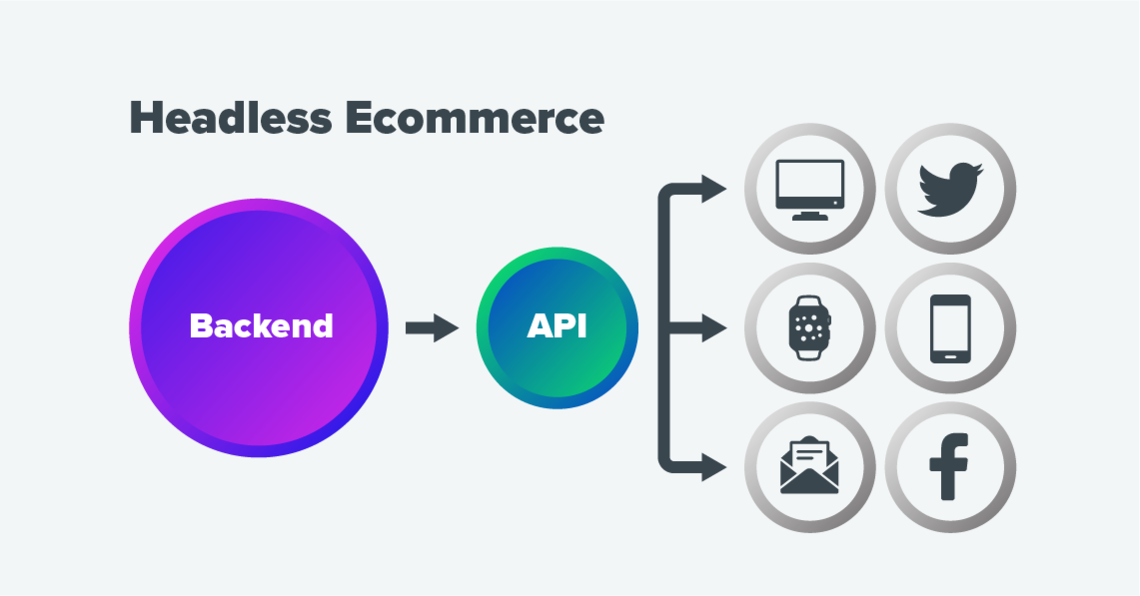Blog
What is Headless Commerce and How to Get Started
Headless commerce is a design architecture where the frontend is decoupled from the backend, providing virtually endless possibilities for ecommerce businesses.

Headless commerce is a design architecture where the frontend is decoupled from the backend, providing virtually endless possibilities for ecommerce businesses.


September 30th, 2022
Headless commerce is a design architecture where the frontend is decoupled from the backend, providing virtually endless possibilities for ecommerce businesses.
You've probably heard the term recently, but do you actually understand headless commerce? Should you consider it for your business? In this blog, we're going to demystify the terminology and technology around headless commerce.
Headless commerce is a design architecture where the frontend is decoupled from the backend. The presentation layer (text, CSS styles, images) is separated from the backend functionality (infrastructure, database, security, checkout) via an API (application programming interface) abstraction layer. The API is the glue between the pieces of the site (e.g., backend, frontend, mobile). This architecture offers brands total freedom to create richer customer experiences without the limitations present in any single platform. The headless system works by passing data between the frontend and backend layers via the API. By separating these layers of the site, development teams can select the best technology for each part of the business.
A headless architecture may seem more complicated than a traditional ecommerce solution, however, this approach offers a number of benefits.
Utilizing a headless approach opens up the possibilities and options a brand can take when developing its business features. Each part of the system is custom developed without limitation. Some of the benefits include:
Custom User Experiences
Flexibility
Speed
Modern Technology
Omnichannel Accessibility
Frontend teams can focus on design using the technology that best suits the desired user experience. The marketing department isn't limited by any specific platform. They can tailor the UI/UX to match the brand. In today's quick-moving ecommerce landscape, brands have to react to buyers’ demands and deliver the customized experiences they're expecting. And some customers have very high expectations!
Technology moves fast and a headless integration allows your business to move at the same speed. Take advantage of new frameworks and technology releases to build better customer experiences.
In a traditional ecommerce platform, you are limited to the features provided by that platform. This is no longer the case as your team has complete control over the experience. Headless commerce lets your development team use any language or framework they want. As technology changes, you can replace parts with more modern versions without having to disrupt the entire tech stack. This flexibility offers up virtually limitless possibilities of what your site can become.
Customers can access your store from a wide variety of devices including mobile phones, tablets, TV, or even IoT devices. Using a headless frontend, you can optimize the experience for each device while sharing the backend business logic. Since the frontend is separated, it's easier to develop custom interfaces no matter which device is being used. You can create a seamless omnichannel experience.
Headless commerce is a blank canvas allowing for versatility to develop the best customer experience for any platform. If you're a brand interested in switching to a headless ecommerce solution, there are several options available. You first need to outline your ecommerce vision to determine the technology needed. Decisions must be made for each piece of the headless architecture. Some aspects to consider:
Frontend Technology
Backend Technology
API Layer
Cloud Hosting
CMS (Content Management System)
Headless commerce is an API-driven solution so the abstraction layer (i.e. the API) is the most crucial element of the development as it connects all of the pieces. The API layer requires integration experience and a development team to handle the creation and ongoing maintenance. You can expect to write custom code and API integration.
Another thing to consider is that going headless may not be the correct approach for every business. If you’re looking for an easy-to-use generic solution with everything in one platform, then a headless solution may not be the best choice for you.
The number of channels for consumers to reach your ecommerce business is growing. You can now expect traffic from phones, tablets, laptops, watches, IoT devices and new technology we haven't even seen yet. Your business needs to keep up and become truly omnichannel. With a headless implementation, your business is optimized for every option, vastly improving your customer's experience. If you're not thinking about headless commerce, then you may be falling behind.
Contact our team of expert headless consultants and we'll review your current and future goals. We'll design a headless architecture that matches your business needs.